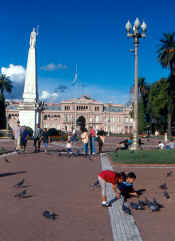

Destinations
Experiences
 |
L A
D A T C O T O U R
S |
 |
||||||||
| HOME | South America | Falkland Islands | Antarctica | Unique Destinations |
Unique Experiences |
Newsstand | ||||
 Casa Rosada |
Buenos
Aires About Buenos Aires
|
BUENOS AIRES
In the words of INSIGHT GUIDE ARGENTINA:
"Buenos Aires: Arguably the most cosmopolitan city in all South America, Argentina's
historic capital has breath-taking energy, spacious grandeur and self-confident style.....
"Despite grand boulevards and hefty, ostentatious architecture, this is a city of villages, or more correctly barrios (districts) - 46 of them. It has been famously described as the Paris of South America, or as travel writer Paul Theroux put it, a "most civilized anthill." It is exuberant, stylish and full of great pretense and hot gossip."
The capital and country’s largest city, Buenos Aires (pop 12,000,000) is often referred to as "The Paris of South America". Sprawling over more than 122 square miles, Buenos Aires lies on the Rio de la Plata which is not really a river but an estuary or great basin some 183 miles long and between 20 and 130 miles wide into which flow the Rios Parana and Uruguay.
Visited by Juan de Solis in 1516, the first settlement wasn't until 1536 when Pedro de Mendoza landed there. After five years he succumbed to the hostile indigenous tribes and moved upriver to Asuncion, Paraguay leaving two important legacies: the city's name, Nuesta Senora de Santa Maria de Buen Aire, and hundreds of horses and cows that were to multiply and later become the foundation of the Argentine economy.
In 1586 a mestizo from Paraguay returned with 70 men and established a permanent settlement. A fortress was built facing the river and the town square, Plaza de Mayo, was marked off to the west.
Buenos Aires was the last major city to be founded. It was considered a backwater village for many years because any Spanish riches were mandated to be transported to Lima for final transport back to Spain. But in 1776 Spain declared what is now Argentina, Uruguay, Bolivia, Paraguay and the northern section of Chile a "viceroyalty". Buenos Aires was made the site of the regional government, and it was catapulted into a position of power.
The heart of the city today, as in colonial days, is the Plaza de Mayo with the Casa Rosada (Pink House - Presidential Palace), the Cabildo (Town Hall) where the movement for independence was first planned and the Cathedral where San Martin, the father of Independence, is buried.
Avenida 9 de Julio is the widest avenue in the world with three multi-laned carriageways. Along it is the Plaza de la Republica with the 41 foot high obelisk commemorating the 400th anniversary of the city's founding, and the Teatro Colon, one of the world's great opera houses.
Tree-lined boulevards, parks & plazas are abundant, adding a special flavor to the city. Among the best known parks are the Palermo Parks, famous for their rose garden, Japanese garden, race track, Botanical Garden, zoo, magnificent avenues and plenty of outdoor excercise areas.
Of the 46 barrios, several are the center of interest for visitors:
NOTE: Buenos Aires has two airports - Ezeiza for international flights and Aeroparque for domestic flights. It takes approximately 45 minutes to travel between the two airports, so if you are making connections allow sufficient time.